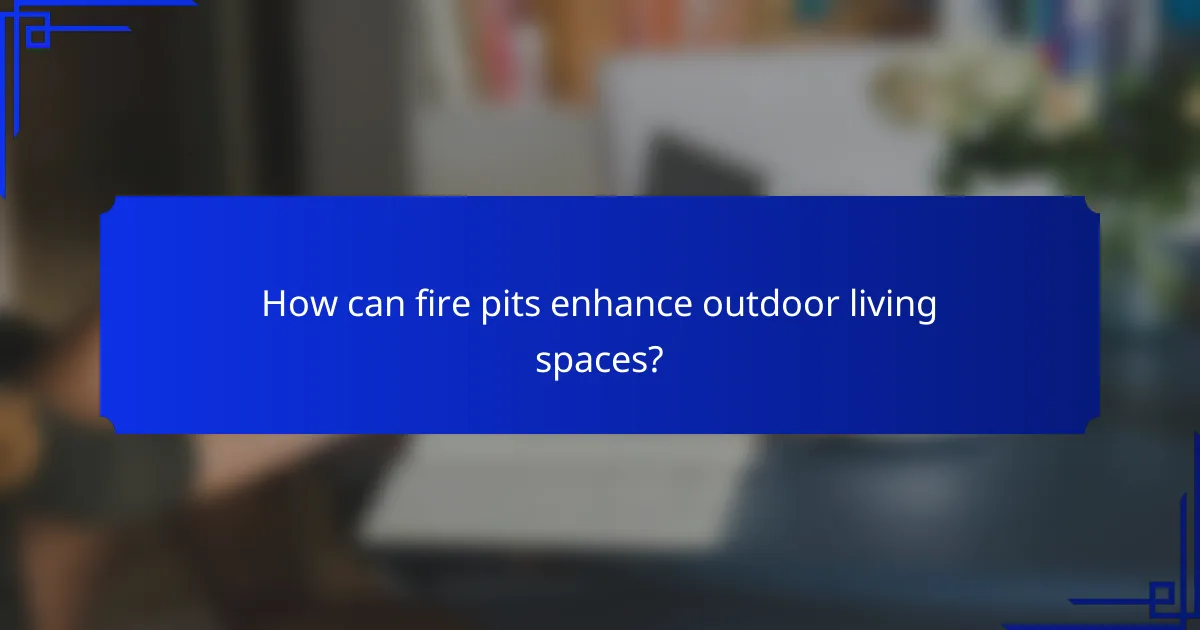As outdoor living spaces gain popularity, the latest trends in patios emphasize stylish and functional designs that seamlessly blend with nature. Homeowners are increasingly incorporating fire pits to enhance ambiance and usability, while thoughtful landscaping with native plants and hardscaping elements creates a harmonious environment for relaxation and social gatherings.

What are the latest outdoor living trends in patios?
The latest trends in patios focus on creating stylish, functional outdoor spaces that enhance living areas. Homeowners are increasingly looking for designs that blend aesthetics with practicality, incorporating elements like fire pits, eco-friendly materials, and smart technology.
Modern minimalist designs
Modern minimalist designs emphasize simplicity and clean lines, often using neutral color palettes and uncluttered layouts. This approach creates a serene environment that allows for easy maintenance and a focus on the natural surroundings.
Key features include open spaces, geometric shapes, and the use of a few high-quality materials. Consider incorporating built-in seating or sleek furniture to maintain the minimalist aesthetic while maximizing comfort.
Eco-friendly materials
Eco-friendly materials are gaining traction as homeowners seek sustainable options for their patios. This includes using recycled materials, sustainably sourced wood, and permeable paving stones that allow for better water drainage.
Choosing eco-friendly options not only reduces environmental impact but can also enhance the overall aesthetic of the patio. Look for products certified by recognized environmental standards to ensure quality and sustainability.
Multi-functional spaces
Multi-functional spaces are designed to serve various purposes, making patios more versatile. Homeowners are integrating dining areas, lounge spaces, and even outdoor kitchens into a single layout.
To create a multi-functional patio, consider modular furniture that can be rearranged easily. This flexibility allows for hosting gatherings or relaxing alone, adapting to different needs throughout the year.
Integrated lighting solutions
Integrated lighting solutions enhance the usability and ambiance of patios during the evening. Options include built-in LED lights, solar-powered fixtures, and string lights that create a warm, inviting atmosphere.
When planning your lighting, focus on layering different types of illumination, such as task lighting for dining areas and ambient lighting for relaxation zones. This approach ensures safety and enhances the overall experience.
Smart technology features
Smart technology features are becoming increasingly popular in outdoor living spaces, allowing homeowners to control lighting, heating, and even sound systems remotely. This integration enhances convenience and can improve energy efficiency.
Consider installing smart speakers, automated lighting systems, or temperature controls that can be managed via smartphone apps. These features not only add luxury but also make outdoor living more enjoyable and functional.

How can fire pits enhance outdoor living spaces?
Fire pits can significantly enhance outdoor living spaces by providing warmth, ambiance, and a focal point for gatherings. They create an inviting atmosphere for socializing and can extend the usability of outdoor areas into cooler evenings.
Variety of styles available
Fire pits come in various styles, including traditional wood-burning, modern gas models, and portable options. Homeowners can choose from different materials such as stone, metal, or concrete to match their outdoor decor. This variety allows for customization to fit personal tastes and the overall aesthetic of the outdoor space.
Some popular styles include sunken fire pits, table-top fire pits, and fire bowls, each offering unique features and visual appeal. Selecting the right style can enhance the overall design of the patio or garden area.
Safety features and regulations
When incorporating a fire pit, safety features are crucial to prevent accidents. Look for models with spark screens, heat-resistant materials, and proper ventilation. Additionally, many local regulations dictate safe distances from structures and flammable materials, so it’s essential to check local codes before installation.
Using a fire pit safely also involves adhering to fire bans or restrictions that may be in place during dry seasons. Always keep a fire extinguisher or water source nearby when using a fire pit.
Fuel options: wood, gas, propane
Fire pits can be fueled by wood, gas, or propane, each offering distinct advantages. Wood-burning fire pits create a traditional campfire experience with crackling sounds and the aroma of burning wood, but they require more maintenance and cleanup.
Gas and propane fire pits provide convenience and ease of use, allowing for quick ignition and adjustable flame control. They typically require a connection to a gas line or a propane tank, which may involve additional installation costs.
Design integration with landscaping
Integrating a fire pit into your landscaping can enhance the overall aesthetic of your outdoor space. Consider positioning the fire pit within a seating area surrounded by plants, pathways, or decorative stones to create a cohesive look. This integration can also improve functionality, making the fire pit a central gathering spot.
Incorporating lighting around the fire pit can further enhance its appeal, allowing for evening use and creating a warm, inviting atmosphere. Use landscape lighting to highlight surrounding features and ensure safety during nighttime gatherings.

What landscaping ideas complement patios and fire pits?
Landscaping ideas that enhance patios and fire pits focus on creating a harmonious outdoor space. Incorporating native plants, hardscaping elements, water features, and seasonal color schemes can significantly elevate the aesthetic and functionality of these areas.
Native plant selections
Choosing native plants is beneficial for both aesthetics and sustainability. These plants are adapted to the local climate and soil, requiring less water and maintenance. For example, in the United States, options like coneflowers and black-eyed Susans thrive in various conditions and attract pollinators.
When selecting native plants, consider their growth habits and blooming seasons to ensure a continuous display of color throughout the year. Grouping plants with similar water and sunlight needs can simplify care and enhance visual impact.
Hardscaping elements
Hardscaping elements such as stone pathways, retaining walls, and decorative gravel can define spaces and add structure to your outdoor area. These features not only provide functional surfaces but also contribute to the overall design by complementing natural elements.
Consider using materials that match or contrast with your patio and fire pit. For instance, if your patio is made of natural stone, using similar stone for pathways can create a cohesive look. Additionally, incorporating seating walls can enhance the usability of your fire pit area.
Water features for ambiance
Water features like fountains, ponds, or small waterfalls can introduce soothing sounds and attract wildlife, enhancing the atmosphere around patios and fire pits. A simple fountain can serve as a focal point while providing a calming backdrop for gatherings.
When planning a water feature, consider its size and placement to ensure it complements your existing landscape without overwhelming it. Small, self-contained units are often easier to maintain and can fit well in limited spaces.
Seasonal color schemes
Implementing seasonal color schemes can keep your outdoor space vibrant throughout the year. Choose plants that bloom in different seasons, such as spring tulips, summer daisies, and fall chrysanthemums, to maintain visual interest.
Incorporating seasonal decorations, like colorful cushions or outdoor rugs, can further enhance the ambiance. Be mindful of color coordination with your patio and fire pit to create a unified look that reflects your personal style.

What are the key considerations for outdoor living design?
Key considerations for outdoor living design include space planning, climate factors, and budgeting for materials. Each aspect plays a crucial role in creating a functional and enjoyable outdoor environment.
Space planning and layout
Effective space planning and layout are essential for maximizing the usability of outdoor areas. Consider how different zones, such as dining, lounging, and cooking, will interact and flow together. Aim for a layout that promotes easy movement and accessibility.
When designing, think about the scale of furniture and features in relation to the space available. For instance, oversized furniture can overwhelm a small patio, while too little can make a large area feel sparse. A common approach is to create defined areas using rugs or landscaping elements.
Climate and weather factors
Climate and weather significantly influence outdoor living design. Regions with harsh winters may require durable materials that withstand cold, while areas with high humidity might benefit from moisture-resistant options. Understanding local weather patterns helps in selecting appropriate plants and features.
Consider incorporating shade structures or windbreaks if your area experiences extreme sun or wind. For example, pergolas or awnings can provide relief from the sun, while strategically placed trees can serve as natural wind barriers.
Budgeting for materials and installation
Budgeting for materials and installation is a critical step in outdoor living design. Begin by determining a realistic budget that includes both materials and labor costs. This will help prioritize features and avoid overspending.
When selecting materials, consider both initial costs and long-term maintenance. For example, natural stone may have a higher upfront cost but could require less maintenance than wood. Create a checklist of must-have features versus nice-to-have items to guide your spending decisions.

How to choose the right contractor for outdoor projects?
Choosing the right contractor for outdoor projects involves evaluating their experience, credentials, and customer feedback. A well-chosen contractor can significantly impact the quality and success of your patio, fire pit, or landscaping project.
Checking credentials and reviews
Start by verifying the contractor’s licenses and insurance. A reputable contractor should hold the necessary licenses required by your local regulations, which can vary by state or municipality. Additionally, check for liability insurance and worker’s compensation to protect yourself from potential liabilities.
Next, read customer reviews and testimonials. Websites like Yelp, Angie’s List, or Google Reviews can provide insights into the contractor’s reliability and quality of work. Look for patterns in the feedback—consistent praise or complaints can be telling.
Understanding project timelines
Discuss the expected timeline for your outdoor project upfront. A reliable contractor should provide a clear estimate of how long the work will take, including any potential delays due to weather or supply chain issues. Typical patio or landscaping projects can range from a few days to several weeks, depending on complexity.
Ask about their schedule and availability. Some contractors may have busy seasons, which could affect when they can start your project. It’s wise to plan ahead and book your contractor during their off-peak times to ensure timely completion.
